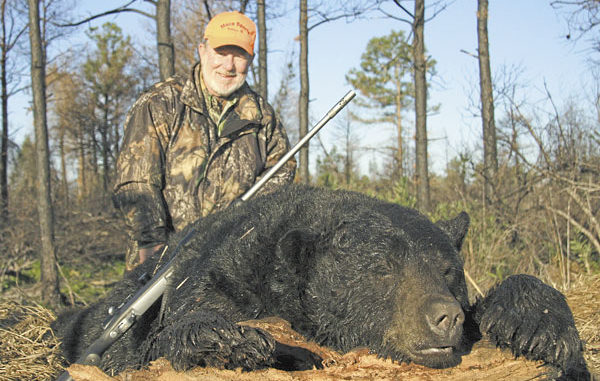
Eastern North Carolina bruin hunting can be tough, but the rewards are worth the effort.
Ralph Britt still looks like he could suit up and catch a footballs the way he did for Tom Reed and Dick Sheridan as an N.C. State tight end in the mid-1980s and for one season with the Pittsburgh Steelers.
Britt, 44, is a 6-foot-3, 220-pound farmer and bear hunter who lives in Mount Olive. Although he’s a little younger than most of the hunters who chase black bears with dogs, Britt enjoys physical challenges. Bear hunting with dogs supplies that in spades, especially an experience that happened in 2007.
“We were hunting near Edenton at some land N.C. State owns,” he said. “It was December and real cold. We had a guy that had killed a bear the dogs had chased all day in ‘the Big Swamp,’ a part we call the ‘Hell Hole.’ The hunter couldn’t find his way out. So me and a couple guys went in to get him, the bear and the dogs.”
By the time they slogged their way to the kill site several miles inside the swamp, the temperature had plunged below freezing, and surface water had glazed over, hiding stump holes that could swallow men and dogs.
“We had to break through the ice on the way in and out,” he said. “We started at 5 p.m. and got out of there, wet, cold and exhausted about 3:30 a.m. the next morning.
“I remember thinking if I was just starting out bear hunting and thought it was like this all the time, I’d quit. And we didn’t even try to get the bear out; we went back the next day for the bear.”
He smiles these days, remembering the grueling test of his stamina and will power.
“It’s one of those things you laugh about later on, but at the time, it wasn’t so funny,” he said.
Hunters who run bears with hounds are a different breed. Having a background in football is not required; all it takes is determination, some physical strength, willingness to tackle hunting the meanest terrain in North Carolina — Down East swamps and thickets where a machete is a tool everybody carries — the desire to maintain a pack of hounds year-round — and a sense of humor.
Hound hunters are a close-knit brotherhood, but there’s another way to hunt black bears that’s more solitary — still-hunting. Mostly it requires some cash for a lease or guided hunt, a powerful, long-range rifle or archery equipment for the extra daring, and the ability to sit in a stand for hours, watching for a bear to appear. As big as some beanfields and cornfields are, some guides like to “spot-and-stalk” bears. They ride slowly on 4-wheelers, trying to spot a distant bear feeding in a field, then attempting to stalk within shooting range for their clients.
Both types of bear hunting also require scouting and talking to landowners to find out where bears can be found and hunted.
If you guessed the two ways to hunt black bear in North Carolina resemble deer hunting, you’d be correct. The only difference, it appears, is that bear hunters are more selective in the animals they prefer to harvest. Bear hunters like larger bruins, mostly males, while deer hunters will take small and large animals of either gender.
Hunting bears with hounds is at least a 300-year-old tradition in the Tarheel State. Still-hunting is a relatively newer approach, although there’s no doubt individual hunters have killed “b’ar” in North Carolina, all the way back to Daniel Boone.
But whether dog or still hunting, Eastern North Carolina offers the best chance to bag a trophy bruin.
Last year, the Parkersburg Hunt Club played host to a collection of hound hunters from communities and towns scattered from the mountains to the coast. Headquarters was a mobile home and several travel trailers parked east of the Aurora community in Beaufort County. About 50 Plotts, Black and Tans, Blue Ticks, Red Ticks, Walkers and mixed-breed hounds were tethered in a large yard, each dog staked outside a plastic sleeping barrel filled with straw.
Greg Peterson, 30, maintains a link to the past with the Parkersburg Hunt Club. He is a nephew of the late Erwin Peterson, a legendary bear hunter and long-time huntmaster for the club. His cousin, Tommy Melvin is now the Parkersburg huntmaster.
For these hunters, chasing bear with hounds is more than a way to put meat in the freezer or a get a bear-skin rug.
“If I couldn’t hunt bear with dogs, I wouldn’t hunt them at all,” Peterson said. “I’m not a fool about (bear hunting), but it’s got into my blood more and more. I took a week off from work to bear hunt this year.
“It’s the traditional style of hunting bear in North Carolina, and people have been doing it a long time. My daddy raised me as a dog hunter, and I hunted deer with dogs for years, but now it seems like bear hunting holds my interest more.”
Peterson shot the second black bear of his life in 2008 with the Parkersburg Club.
“It’s like that for a lot of the fellas,” said Junius “Junior” Andrews of Gibsonville, who has been a bear hunter for most of 60 years. “I don’t even tote a gun. I just like hearing the dogs run a bear.”
Jerry Pitts, a retired insurance executive from Burlington, carries a camera when he hunts with the Parkersburg club.
“I’m into photography,” he said. “I like taking pictures of bears. (I) haven’t killed one in years”
Although hunting bears, listening to the dogs run and ultimately getting a chance to take a huge bruin are important, they probably take second place to something else that’s never spoken — the friendships and fun that occur when the hunters gather at the end of the day to talk about the hunt, enjoy a meal, tell yarns, trade talk about dogs and poke fun at one another.
Troy “Pea Juice” Mitchell of Princeton told a tale that was at once dangerous but whose telling left the Parkersburg members holding their sides in laughter.
“I was hunting with M.G. (Futrell, a farmer from Goldsboro) once, and it was getting dark,” Mitchell said. “The dogs had been runnin’ a bear, and it treed, but M.G. and me had got separated.”
Hunters losing contact is commonplace, given the thick, briar and tangle infested woods they encounter.
“I was at the tree, but I didn’t have a light, and I didn’t have a gun,” Mitchell said. “So the bear decides to jump out of the tree.”
In the dark, Mitchell suddenly became aware that Futrell had the only weapon, and the bear might decide to attack the nearest creature that wasn’t barking.
“I heard (Mitchell) hollerin’ ‘M.G.! Come back! Come back!’” Futrell said.
Mitchell’s terror made him sound like child-actor Brandon DeWilde, calling for Shane to return in the 1950s classic cowboy movie.
“Hey, the bear did come by me, but I think he was more scared than me,” Mitchell said. “He ran past me and never stopped; I could hear M.G. laughing.”
The bear escaped with only a good fright, which isn’t unusual.
“I’d say we kill about one out of eight bears the dogs bay,” Andrews said. “It’s all about the dogs for most of us. We don’t take small bear, females if we can help it, or females with cubs.”
On opening day of the 2008 bear season, the Parkersburg club and visitors saw at least 15 bears (several small bruins crossed roads within shooting distance of hunters but were deemed too small), but only one male bear was harvested.
The landowner who had leased the club his land had a teenage son who wanted to kill a bear. The dogs treed, and the landowner and son fought their way through a thicket to the bear, but Melvin, Andrews and other members of the club convinced them the bear was too small.
That afternoon, Peterson killed his second bear, a 344-pound male, inside a thick block of pines, holly trees, pin oaks and poplars with undergrowth marked by face-scratching canebrake briars, other clinging vines, thick reeds and yaupon bushes. The block of woods was framed by a gravel road, a Pamlico feeder creek and a local paved highway. Hunters stood every 300 or 400 yards in case the bear decided to leave its sanctuary and cross one of the roads. But he didn’t; the big male finally turned with his back to a big poplar and faced his pursuers — six bear hounds,
During the chase, Peterson and Futrell became separated.
“We felt like the dogs would run the bear by one of us,” said Peterson, who dropped the bear with a neck shot from an unscoped .30-30 rifle at a distance of 15 feet as it fought the dogs. A minute earlier, Futrell had popped the bear with a .45-70 slub that seemingly caused no ill effects.
Eight club members hacked a trail from the road through the thicket to reach the bear, then they used a homemade rope-and-harness (with cut saplings as whippletrees) to drag the bear a quarter-mile to the road.
“Greg will get the skin and each of the club members gets a portion of the meat,” Andrews said.

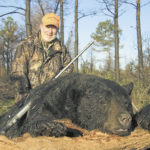
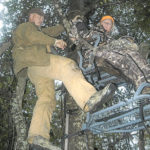
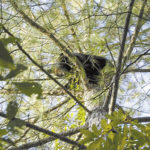
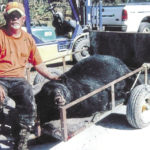
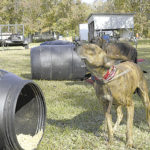
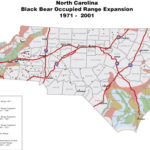



Be the first to comment